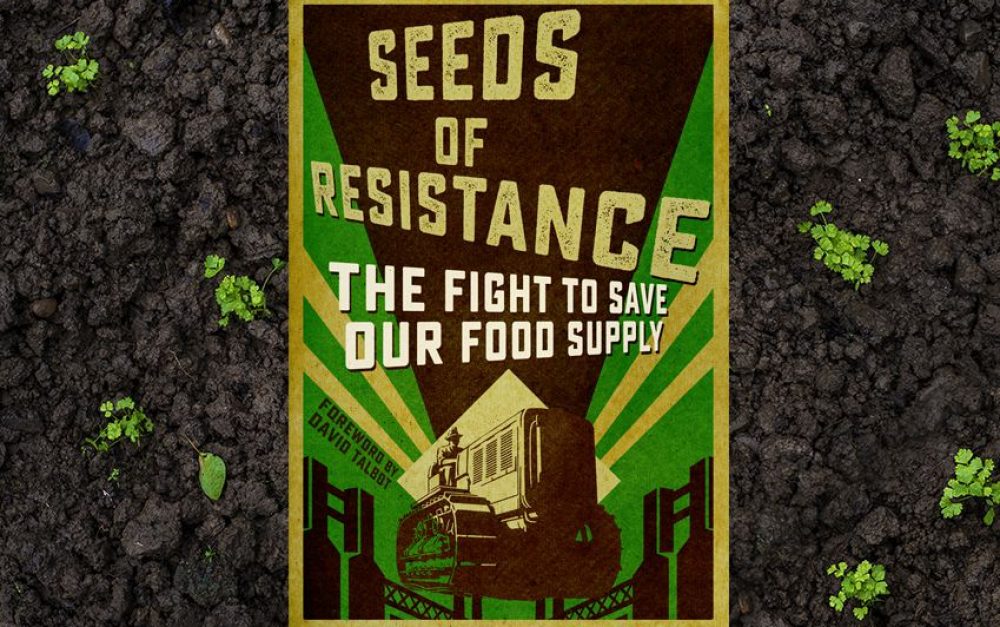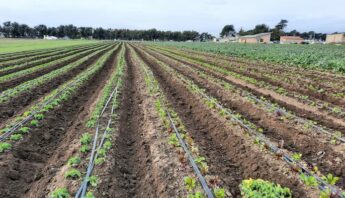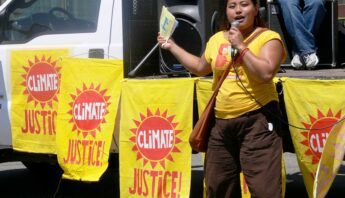PAN recently spoke with author Mark Schapiro about the state of our food and farming system and the release of his new book Seeds of Resistance — “an expose of the high-stakes battle underway for control of the world’s seeds as climate volatility threatens the security of our food supply.”
PAN recently spoke with author Mark Schapiro about the state of our food and farming system and the release of his new book Seeds of Resistance — “an exposé of the high-stakes battle underway for control of the world’s seeds as climate volatility threatens the security of our food supply.”
PAN: You just released a new book, Seeds of Resistance. What’s that about?
Mark: Seeds of Resistance is about the ground-zero ingredient of our food — seeds. I investigate two converging forces: on the one hand, the accelerating shifts in growing conditions being wrought by climate change. And on the other, the accelerating rate of corporate consolidation in the seed industry. I search for the seeds we need to deal with climatic disruptions, and the fight underway to control them. Which is also interesting, a real dive into the thriving movement around this country and around the world to resist the corporate trends and assert autonomy over locally evolved seeds — which often also are the very ones showing the greatest resilience to climatic shifts.
I explore the importance of biodiversity in an agricultural and ecological system, and why biodiversity is critical for our ability to respond to climate change. And I also discuss the price we pay as community members, farmers, scientists, and civil society for not retaining autonomy over our seeds.
PAN: How have you seen the control of our seed supply shift? What mechanisms have led to this shift?
First, the move of multinational agri-chemical companies into seeds has led to the situation now; more than half of commercially traded seeds are controlled by 3 companies. And those companies are also chemical companies.
Bayer (which now owns Monsanto), one of the biggest chemical companies, bought America’s biggest seed company (Monsanto). Dow and DuPont merged, which in the seed realm is branded as Corteva — these are two of America’s largest chemical companies, now merged. And Syngenta, the biggest chemical company in the U.S. merged with ChemChina, the biggest chemical company in the world.
The common thread here? Chemicals. These three now-merged companies are producing seeds dependent on their mother companies’ chemicals to survive. Which has major implications for our food supply and our ability to deal with climate change.
This happened in part due to a sequence of Supreme Court decisions in the 1980s that established the ability of companies to patent seeds. I describe in the book how after each of several court decisions steadily expanding the law to encompass and enforce seed patenting over about a decade, first Monsanto and then other chemical companies began to buy local seed companies. There’s a direct link between the patenting laws and the moves of chemical companies into seeds. Monsanto was the first company to patent seeds. After each successive Supreme Court decision, a new rash of corporate purchasing of seeds happened.
Another factor was the emergence of GMOs which began significantly emerging in the 90s, which enabled companies to put a very specific brand on their seeds, and each seed had a distinctive genetic footprint which was recognized in a court of law.
The development of GMOs accelerated corporate power for several reasons. They give seeds a highly specific genetic fingerprint — based on the introduction of non-related species into the plant’s genome — that enable companies to enforce their patents with precision. Over time, this changed farmers from being the stewards and creators of seeds and varieties into people who, essentially, are leasing a set of traits provided within the seed by a specific company.
Third, and they’re all related, was the realization by the chemical companies that they could breed seeds to be dependent on their own chemicals to survive. And make a profit on both ends of that deal — on the seeds and on the chemicals they need to survive.
Whatever your feelings are about this system and the way it has changed power relationships in agriculture, it is undeniable that it is showing great signs of vulnerability under climate change. So the question is — how do we respond? My book reveals where these threats are, and how communities are responding.
PAN: You titled this book “Seeds of Resistance”, so we know the work to change this system is already underway. What does the future of seeds and our food and farming system look like?
One of the things I’ve learned in the process of reporting and writing this book is an understanding of the Earth as a single living organism. Earth is a single organism. I think what I came to understand more deeply than I ever had after thirty years of doing environmental journalism was how the process of growing food fits into that vast ecological idea: conjuring food from the Earth is a complex, and even beautiful, system arising from the balance between three basic elements — water, sun, soil. That balancing act is undergoing major and highly disruptive stresses as a result of climate change.
The industrial model of agriculture calls for detaching the seed from the environment around it, using chemicals to boost what’s missing in their locally evolved genetics. And the vulnerabilities of that system are showing, not only from the public health consequences of using agrichemicals, but time after time have been shown to be brittle and are not resilient to the enormous changes underway. Climate change is shining a harsh light on these vulnerabilities.
I also explore the multiple responses to this crisis in our food system and found time and again that in many instances those responses are staring us in the face, hiding in plain sight — in the soil and in the seeds that have responded over many seasons to stressful conditions.
It’s clear we cannot rely on chemicals to get us through this. There is abundant and growing science affirming the principles that biodiversity is key to climate adaptation, and that organically rich soils are far more resilient to change than those cultivated in depleted fields reliant on chemicals to survive.
I don’t think there’s a single “solution” to help us navigate through perilous times. But, there are a lot of new ideas, many of which are actually old ideas grounded in knowledge of the soil, and a sensitivity to how seeds respond to different ecological conditions. I explore many of these practices, and the people and communities behind them, in Seeds of Resistance. My point with the book was not only to highlight the dangers ahead, but also how across this country and around the world, people are fighting to maintain autonomy over their seeds, and farmers and scientists and engaged citizens are showing us promising ways forward.
For one example, in the process of reporting I visited Arizona — which in many ways offers a portent of agriculture as the rates of climatic change accelerate. The state is a center of industrial agriculture in the U.S., featuring vast, highly saturated chemical fields in an arid environment. At the same time, we have this incredible flourishing of Native agriculture, and people have been growing food in these difficult situations for several thousand years. The oldest and most evolved domesticated agriculture in what’s now the US is in the southwest. It’s interesting to see the increasing, and very belated, attention to the way that Native people have grown food over thousands of years. There is a growing recognition that methods used, for example by the Hopi people and Tohono O’odham people, will help us survive these climate disruptions.
PAN: Wow, thank you for this! I know you have a long-standing connection to PAN and our work. Tell me about your work with PAN, and what role you see PAN playing in the resistance to the control of our seed supply, and the fight for a more just future?
This goes way back to the book, Circle of Poison. In a sense, Seeds of Resistance is like my own return to reporting on the food system, and brought me back to the earliest days of PAN. I co-wrote Circle of Poison (with David Weir) investigating the export of banned pesticides to the developing world. Reflecting back, I think I saw the central issues then as ones of public health and, of course, morality. The exposure of people in developing countries to highly toxic substances that those of us in developed countries were protected from — that’s a profound moral and public health problem. Not to mention, we get the banned substances in our food residues — just illustrating how, in so many powerful ways, we are all connected.
I recall those early days of PAN, which was founded as a way to redress this threat to public health on both sides of this double standard. Well, it’s been several decades since then, and what I noticed and came to appreciate was how once you start with how food is grown — chemicals or not? — you get into the far bigger question of how we treat the Earth, how we perceive the multiple layers of ecological resources on this planet. And I’ve seen that PAN, while founded in the struggle to limit the poisonous impacts of agrichemicals, moved in a sense naturally toward the deeper questions of how we relate to the lands that supply us with food. PAN has in many ways pioneered the path deep into our food system that began with fighting the hypocritical double standard around pesticides. The idea at the root of intensive chemical use is to distance seeds from the actual ecological conditions in which they are growing, which has very negative impacts on the soil, atmosphere, and the people who work in fields saturated with chemicals. I see a direct connection between the efforts of an organization like PAN to reduce or eliminate agricultural chemicals and our ability to have a food system resilient to the climate crisis.
What PAN is doing now and what it has become over the last 35 years — starting with this idea of protecting people from the environmental health hazard of pesticides — is to follow those threads where they lead, into the practices for growing food that are more regenerative and far less environmentally damaging to the ecology of our shared planet.
And in many ways I see Seeds of Resistance as a continuation of what we let loose with Circle of Poison.






